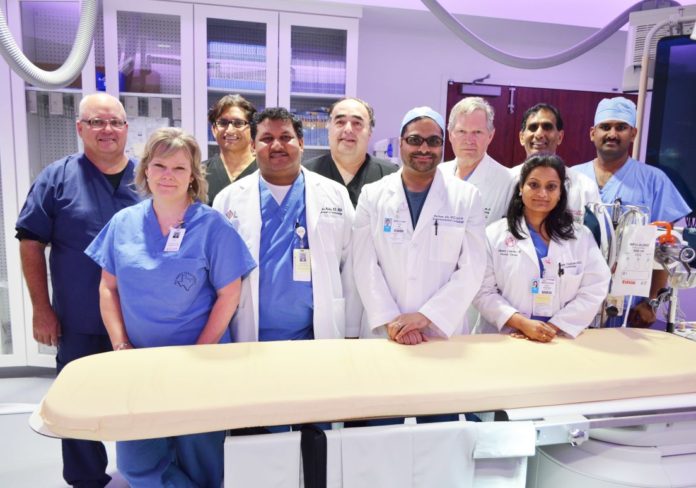American Heart Association
www.heart.org
Dr. Amir Malik has put Plaza Medical Center on the medical map for a procedure the hospital says is new to Tarrant County but gaining momentum nationwide.
Known as transcatheter aortic valve replacement, the newly approved procedure allows patients too weak or at high risk for traditional heart surgery to receive a new valve to control blood flow from the heart.
“We are seeing more and more people having this problem,” said Malik, lead physician on Plaza’s transcatheter aortic valve replacement (TAVR) team.
Up to 1.5 million people nationwide suffer from aortic valve stenosis, a narrowing of the valve controlling critical blood flow from the heart, according to the American Heart Association. The number of deaths from heart failure caused by aortic valve disease has risen by 35 percent in the past decade.
“This will allow those in Fort Worth who might benefit from this to have a type of procedure that wasn’t available here before,” said Malik, who joined Plaza in September 1988.
The U.S. Food and Drug Administration chose Plaza Medical Center due to its total number of related cases and surgical outcomes, among other criteria. After the FDA approved TAVR for patients whose condition was considered extremely high risk, the agency and Medicare restricted the procedure to facilities meeting Medicare’s national coverage determination requirements for medical staff expertise and cardiovascular patient volumes.
About 100 hospitals nationwide now offer TAVR, including some in Dallas, Houston and Austin. And only one Fort Worth physician is qualified to perform the procedure, according to the hospital.
“Dr. Malik was the only doctor qualified to do this,” said Steven Albright, the medical center’s program director of cardiovascular services. That’s due, in part, to the number of heart surgeries Malik has done.
“As demand grows and volume increases, I’m sure more doctors will take part in this,” said Malik.
After years of perfecting a procedure pioneered by French cardiologist Dr. Alain Cribier and brought to market by Edwards Lifesciences, the FDA in 2011 approved what’s known as the Edwards valve for high-risk patients. Medtronic, which manufactures a similar device, received the green light for its aortic valve in June 2014. And after being limited to clinical trials, the Edwards valve recently received FDA approval for high-risk patients.
Howard Jacobs, 83, became the first Fort Worth beneficiary when the retired restaurant and municipal worker underwent the procedure on May 20. Only two days after receiving his valve, he was released from the hospital and soon found himself dining out and working around the house.
Like most TAVR patients, Jacobs is in his eighties. A handful are in their sixties, but most patients requiring new valves are older because heart valves often become problematic as the body ages, Malik pointed out.
“People are living longer, and this [aortic valve stenosis] is predominantly a disease of those who are 80-plus,” Malik said.
Although the procedure is considered minimally invasive, replacing the valve is tricky. Unlike traditional open-heart surgery, surgeons doing TAVR place a new valve in a catheter and send it upstream from the groin artery. Once it reaches the heart, it opens like an umbrella.
The procedure also is expensive. Medicare reimbursement for hospitals tends to be a break-even situation due to what hospitals pay valve manufacturers. That’s not unusual when new technologies and procedures are implemented. Exactly what patients pay could not be confirmed.
“This is a relatively new procedure, but Medicare does cover it,” Albright said.
Plaza did not need any new equipment for the procedure; it uses its existing imaging systems, catheterization lab and staff. The heart valve manufacturer also provided some specialized equipment to help launch the program, a common practice when introducing new technology.






